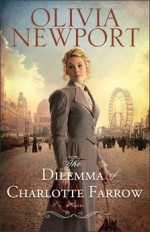We ask Olivia Newport five questions about
The Dilemma of Charlotte Farrow (Revell Books): A house maid, a wealthy family, and a secret child come together for high drama during the 1893 World’s Columbian Exposition in Chicago.
WHAT WERE YOUR GOALS WHEN WRITING THE DILEMMA OF CHARLOTTE FARROW?
This story is the second in a series, so one of my goals was to take readers back to a familiar setting and characters. Charlotte was introduced in The Pursuit of Lucy Banning, but her backstory was left a mystery. I hope returning readers get some satisfaction from knowing Charlotte better. I also wanted to raise the question of how we perceive God’s will and explore it in a story where the answers are not cut and dried.
THE SETTING FOR THIS BOOK IS 1893 WORLD’S COLUMBIAN EXPOSITION, WHAT ABOUT THIS HISTORICAL PERIOD THAT PIQUED YOUR INTEREST?
I grew up in Chicago suburbs, and one of my favorite places for field trips and family outings was the Museum of Science and Industry. I didn’t realize as a child that the building housing a museum that fascinated me was a rare remaining structure of the 1893 fair. So that caught my interest. Then I learned about the Prairie Avenue Historic District and the real families who lived there that were the backbone of industry for Chicago and the whole nation. After I visited the Glessner House Museum I was smitten.
DID YOU DO ANY SPECIAL RESEARCH FOR THIS NOVEL? HOW FAMILIAR WERE YOU WITH THIS PERIOD BEFORE YOU WROTE THE BOOK?
I had a lot to learn not so much about the period more generally but about the specific setting on Prairie Avenue and particular events in Chicago’s history. I dug pretty hard to get things as right as I could. The fact that the Glessner House has been restored in a faithful way based on photographs was very helpful.
WHERE DO YOU DRAW THE LINE BETWEEN HISTORICAL ACCURACY AND TAKING DRAMATIC LICENSE?
I’m pretty particular. My approach is to investigate events and details thoroughly and then put characters in the middle of events we know really happened. That’s what consistently fascinates me when I visit historical places: real people lived through the times and turmoils that we read about and that seem distant from us. When we imagine how with the same emotions and conflicts we experience might have responded to events, then we have a good story. I was constantly checking and double-checking historical details, right down to what babies ate in 1893.
WHAT ARE THE LESSONS OF THAT ERA THAT ARE STILL RELEVANT TO READERS TODAY?
I began writing this series in 2009, right after the bottom fell out of the economy for us. Despite the standard of living—excesses, really—of the families on Prairie Avenue, the country was in an economic depression in the 1890s. Over the years of bringing this series to publication, I have been struck more than once by the issues of economic injustice and political responses that ring so familiar between 1893 and the present day. In the contrast between Lucy Banning and Charlotte Farrow (and Sarah Cummings in the third book), we have a microcosm of issues that remain unresolved 120 years later. The lesson is that whether in the nineteenth century or the twenty-first, we must remember that the issues are not theoretical but about real people seeking meaning and fulfillment.


